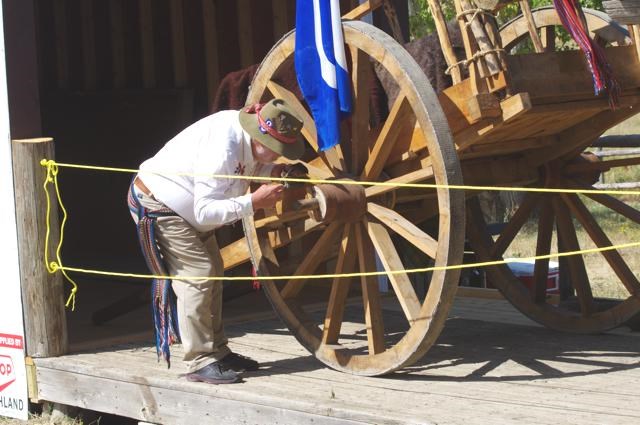Submitted by David L Munro
The Friends of the St. Victor Petroglyphs hosted a wonderful afternoon for the opening of the Red River Cart Display at the St. Victor Petroglyphs Interpretive Centre in St. Victor on August 26. The event welcomed 26 visitors who came to learn about the Red River Cart and to support the Interpretive Centre.
Brian Kuysten helped to build the cart and donated it to the Friends of the St. Victor Petroglyphs. Kuysten spoke about the history of the Red River Cart and the importance of the cart during the 1800s and into the early 1900s. As part of the event, there was a dedication ceremony. Kuysten performed a smudge of the cart and talked about the meaning of the smudge and the plants in the smudge pot. He also spoke about the significance of the ribbon and the sash which were tied onto the cart. Kuysten was on hand to answer questions and visit. Visitors were invited to stay for a barbecue of smokies on a bun.
Kuysten stated that he helped to construct the cart over the course of the year. He collected woods from Manitoba and Saskatchewan, including green oak and ash from Manitoba, and diamond willow from Quill Lake in Saskatchewan. It was a time-consuming process. The wood was seasoned for a year before construction. He spent eight hours just making the axle with a draw knife. There were no nails used in the cart’s construction, only dowels and mortices.
The Red River Cart first appeared at Fort Pembina just south of the Manitoba-North Dakota Border in 1801. The cart may have been derived from the charrettes used in French Canada or the cart used by the Scottish descendants of Lower Canada. The cart was made from local wood and did not use iron due to its cost. At the same time, this made them easy to repair along the prairie cart trails. The larger carts were used to carry furs and materials weighing up to 1,000 lbs., or 450 kg.
The first carts were pulled by small horses obtained from the First Nations people just west of the joining of the Red and Assiniboine Rivers in Manitoba. After the establishment of the Selkirk Settlement, oxen became the main power to pull the carts due to their strength, stamina and split hooves which aided in movement through mud.
Red River Carts were commonly seen passing through St. Victor on their way to Wood Mountain and on to Cypress Hills. Part of this wagon trail is still evident near St. Victor. Part of this trail will become an outdoor mural on the shed which houses a Red River Cart at Monarch Lodge in St. Victor.




